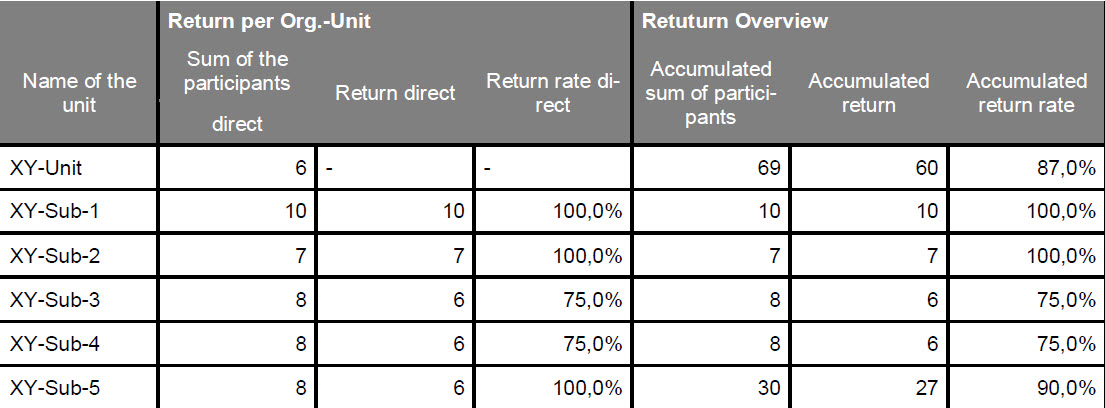Overview
This article provides information on the Anonymity Criterion and Remainder Rule, which are used to protect participant privacy in survey results. It explains how these rules are applied, their impact on data display, and options for deactivation.
Information
The Anonymity Criterion and Remainder Rule are essential for maintaining participant confidentiality in survey results. This guide explains how these rules work and their implications for data presentation.
Anonymity criterion
Return per unit and question is only displayed for 5 or more participants.
-
If less than 5 participants completed the survey, the direct return will be hidden in the Org-Processor.
-
If (accumulated return – return direct) < 5, the direct return will be hidden too.
-
If an accumulated return is < 5 as well, the accumulated return will be hidden.
-
If the sum of the accumulated return is < 5, direct as well as accumulated return will be hidden
Remainder rule
Additionally, the remainder rule is activated: ‘For reasons of anonymity, the return is not shown until a minimum of 5 is reached. Furthermore, the sum of the return of hidden parallel units also has to reach the minimum return. As long as this is not the case, the unit with the next higher return is also hidden.’
Example
If the sum of the return of three hidden units is < 5 (e.g. all of these three units consist of only one participant; sum = 3), at least one other parallel unit (always the unit with the next higher return) will also be hidden until the sum of the hidden returns is ≥ 5.
-
As soon as the hidden three units reach a return of ≥ 5 in total, the hidden unit will be shown again.
-
As soon as one of the hidden units reaches a return of ≥ 5, it is displayed again (of course only if the other two units combined reach a return of ≥ 5; otherwise it will stay hidden).
If all parallel returns are displayed and the direct return of the higher-level unit is hidden, the accumulated return of the superordinate unit is hidden as well.
Deactivation
Additionally, the box is disabled: ‘Include units with a return rate of 0 for remainder rule‘.
-
If disabled and one unit’s return equals 0, there will not be any other parallel units hidden with a return of ≥5. Once an employee participates, the remainder rule applies again (see 1.2.). See the process between screenshots 2 and 3: on November 7th, Org-Unit D’s return = 0, on November 9th, it is between 1 and 4. As a result, the return of the parallel unit Org-Unit C will be hidden on November 9th.
-
If enabled, a parallel unit would be hidden on both dates, November 7th and November 9th, in the same case (only one unit with return = 0).
Return on 11/07/2016
Return on 11/09/2016
Additionally box is disabled: ‘Suppress accumulated return for units with suppressed direct return, if it can be used to calculate the direct return’.
-
If disabled, accumulated returns (for units with subunits) will be shown, even if the direct return is hidden. Under certain conditions, this may cause Directs to be counted back from Parent Units.
Suppress accumulated return disabled
The direct return for the XY-Unit is hidden due to the anonymity criterion. The sum of the accumulated returns of all sub-units adds up to:
-
10+7+6+6+27 = 56
The accumulated return of the parent unit (XY-Unit) is also displayed in the export: 60. By subtracting the sum of the accumulated returns of all sub-units from the accumulated return of the parent unit, the direct return of XY-Unit can be calculated:
-
60-56 = 4
If enabled, accumulated returns will be hidden only, if they can be used to count back on directs. This suppression may affect the remainder rule (see also 2.)
in such a way that suppressions are ‘cascaded’, and even large units will no longer display accumulated returns.
FAQ
What is the minimum number of participants required to display return data?
The minimum number of participants required to display return data is 5. This applies to both direct and accumulated returns.
How does the Remainder Rule affect data display?
The Remainder Rule ensures that even if a unit has 5 or more participants, its data may still be hidden if showing it would allow the calculation of hidden data from other units. This rule is applied to maintain overall anonymity across parallel units.
Can the Anonymity Criterion and Remainder Rule be deactivated?
While these rules cannot be completely deactivated, there are options to modify their behavior. For example, you can choose whether to include units with a return rate of 0 in the Remainder Rule calculations, and whether to suppress accumulated returns for units with suppressed direct returns.




Priyanka Bhotika
Comments